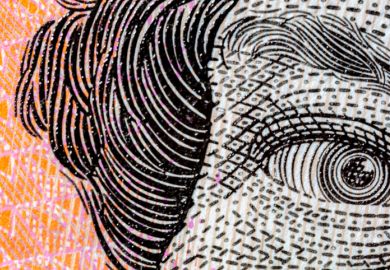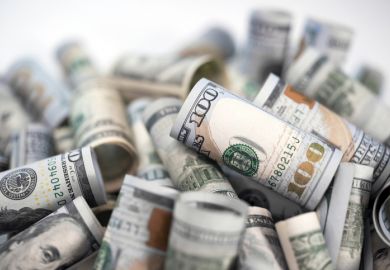Los Alamos has produced more than its fair share of tales charting the exploits of curious characters, and Thomas Bass's The Predictors introduces us to a new crop. Bass outlines the history of an applied research project that has given rise to many tales over the past ten years. How roughly a dozen physicists, including founders of nonlinear dynamics (chaos) and some of the most promising young theorists in the field, joined together to tap an under-exploited source of research funding: the stock market.
The book is well written and entertaining, repeatedly exploiting the contrast between the breakneck speed of those "running" the world's financial markets with the laid-back reflections of life in New Mexico. It begins with a colourful account of a feeding frenzy in a pit in Chicago. Whether on LaSalle Street outside the Chicago exchange or on a boat deep-sea fishing off the Florida coast, the real activity of a feeding frenzy is usually beyond the sight of all but those participating; from above one only sees a spot of bubbling white water where the "one that got away" fails to get far. Bass shifts from the midst of the action to the quiet view "outsiders" get of the financial markets, alternating between those trying to survive inside the market and those trying to predict it from outside.
Bass tells the story of a mixing of cultures: scientists and traders, Chicago and Santa Fe, speculators and hedgers, Pueblo Indians and Spanish conquistadors - all seeking riches in New Mexico. The Prediction Company's (PredCo) goal is well defined: use the latest insights in the theory of nonlinear dynamical systems (and whatever else is needed) to produce an automated trading system that wins more than it loses on average and never loses too many times in a row.
Bass's book is meant for a general audience with no previous insight into either Wall Street or physics (or "phynance"). Beautiful pictures are drawn of how both the markets and the people in them function, or fail to function, always covering their options in any case. Clear and accurate explanations are given for why access to sufficient data, especially new, unseen data, is at least as important as access to trading capital; other statistical and computational realities of operating in today's financial world are made intelligible. At the end of the book, the general reader will have a deeper insight into the way the markets work and what is required to have a chance of predicting them.
In New Mexico, the passage of each year is marked with the burning of Zozobra, a 12m puppet of Old Man Gloom, which takes place each September during the Santa Fe Fiesta. By chance, PredCo was incorporated in September 1991, just in time for the fiesta. Over the following years, both the ceremony itself and its evolution serve as a mirror in which we are shown the evolving thoughts of the predictors, how they view the state of their company, their research and their ultimate goals. Bass traces the ascent of PredCo as it searches for a partner rather than a predator. Indeed, much of this story is one of courtship: how do you exchange insight for access? Barter understanding for a piece of the action? All you have to offer is expertise and potential, all "they" have is data and cash. How to build a relationship where they do not own you, and you cannot exploit their resources and then walk away? Good science is not enough, some hard negotiating is called for; even a suit.
The tale is entertaining, but it soon becomes clear that this is the general admission version: while there is some romance, almost everyone wears a white hat, we see no real villains, there is certainly no sex. This is disappointing, since PredCo stories abound on Wall Street, in the City and at physics conferences worldwide.
Regrettably, the book does not even comment on many of the most interesting of those in circulation. Was their first winning model really running on crossed data inputs? Was PredCo funded as an investment or as an insurance policy? And what happened to the junior partners, all of whom left the company, some unexpectedly? What was the nature of the conflict that drove each of them away? Scientific, business or social? Their departure signalled the end of the Eudaemonic ideal, the idea that by working together, a band of scientists could beat the system and make plenty of money for all. This ideal had served as the driving force behind both PredCo and Eudaemonic Enterprises, the latter documented by Bass in The Newtonian Casino (1985). Is buying into the management-employee hierarchy an unavoidable (predictable?) result of scientists being snookered into adopting a corporate culture?
While it would be naive to expect to learn "how they did it", or perhaps even that they did it, deeper insight into the inevitable failures, personality clashes and difficulties of combining these two cultures are sorely absent. And there are virtually no numbers: given the changes in technology and the markets themselves over the past five years, why can we not have a more quantitative view of what was happening back in 1996?
In The Newtonian Casino , Bass managed to describe personalities as well as the basic physics behind beating roulette (the original bakery for the Eudaemonic pie) without conflict of interest, and Reinventing the Future (1994) is frank about conflict in science. Perhaps the clash of cultures is reflected by The Predictors as well as within it: the text may well have suffered in the feeding frenzy it attempts to describe. Nevertheless, it provides the deepest insights available into yet another curious tale from the New Mexican desert. Unfortunately, those hoping to find detailed instructions on how to make money will be disappointed.
Leonard A. Smith is reader in statistics, London School of Economics, and a senior research fellow in mathematics, Pembroke College, Oxford.
The Predictors
Author - Thomas A. Bass
ISBN - 0 7139 9342 1
Publisher - Allen Lane The Penguin Press
Price - £18.99
Pages - 309
Register to continue
Why register?
- Registration is free and only takes a moment
- Once registered, you can read 3 articles a month
- Sign up for our newsletter
Subscribe
Or subscribe for unlimited access to:
- Unlimited access to news, views, insights & reviews
- Digital editions
- Digital access to THE’s university and college rankings analysis
Already registered or a current subscriber? Login



